
RHP Conner Griffin, freshman at Binghamton University, started remote training with us in October of 2022 going into his senior year of high school. He came in at 6’5” and 188 lbs., sitting 88-90 mph with his fastball. Fast forward to this past August 2023 when he came back for a re-assessment, he weighed in at 200 lbs. and his fastball was sitting 90-93 mph (most recently this fall touching 95 mph at Binghamton).
How did he do it?
The Process
When athletes return for a reassessment, whether in-house or remote, we are generally looking for how their metrics have changed and / or improved since the prior assessment. This helps us continue to focus on the lowest hanging fruit at every step of the way, while not taking away any of the attributes that they already possessed on Day 1.
Conner’s lowest hanging fruit on his initial baseline assessment were:
-
- Lean Muscle Mass
- Shoulder and Hip Mobility / Stability
- Strength and Power
Lean Muscle Mass
In August, during his reassessment, Conner weighed in at 200 lbs., a 12 lbs. increase since he started training with us.
-
- October 2022 – 188 lbs.
- August 2023 – 200 lbs.
There are a number of items that we believe have helped Conner increase his velo ceiling and increasing his lean muscle mass is at the top of the list. When looking for ideal BW for our athletes we look for a ratio of 2.5-3.0x their height in lbs. combined with a <15% body fat percentage. Conner’s BF % at the initial assessment was 6%.
At 2.6x, he is now clearly in the range, with some additional room for further improvement.
Shoulder and Hip Mobility / Stability
His initial assessment highlighted several areas of shoulder and hip mobility / stability that we needed to address. Lets review a couple of these and the improvements we noticed in the reassessment. In each case, we will highlight the results of the initial assessment and the reassessment.
-
- Shoulder IR (throwing shoulder) – Compensations in shoulder IR can among other things cause shoulder impingement as well as poor pronation at release. With Conner, we worked on lower trap and serratus strength, thoracic extension as well as soft tissue work to pec minor and levator.

-
- Shoulder Scaption (both shoulders) – Conner’s cuff strength showed weakness in scaption this is primarily the Superspinatus which is responsible for depressing the humeral head into the socket when beginning to bring the arm overhead. The goal here was to strengthen the muscles that position the scapula so that there is more clearance through which that tendon can pass under the acromion process.
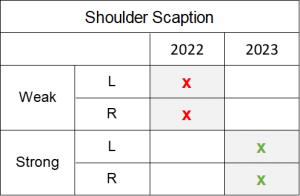
-
- Hip Abduction Strength – The primary muscles here are the glute med / min and piriformis. These muscles are critical to stabilizing the pelvis / trunk in order to maintain upright posture and control motion when coming down the mound.

Strength and Power
When an athlete is able to increase his max strength, it allows for the potential for a higher power output as a consequnce. From 2022 to 2023, Conner increased his max strength across the board.
Although already pretty strong, his deadlift, bench, and squat and power metrics all increased across the board.
Strength
-
- Deadlift (lbs.) 474 > 504
- Bench Press (lbs.) 196 > 208

August Reassessment
Lower Half Power
-
- CMJ Jump (watts) 4734 > 5272
- Squat Jump (watts) 4388 > 4786

August Reassessment
Mechanical Improvements
From our motion capture and video analysis in 2022, we prescribed a few movement correctives to help him improve his overall delivery on the mound. They included:
-
- Walking Torque – To improve Conner’s overall posture and glove side timing within his throw.
- Figure 8 Rocker – To improve Conner’s arm path (late arm) and also his trunk being properly stacked over his pelvis.
- Step Back – To specifically improve Conner’s early heel rotation and additionally his overall positioning of his lower half during the load.
- Step Behind – To add additional work with his lower half positioning and timing in a more athletic movement.
The following disconnects were some of our main points of focus throughout the past year. All of which showed improvement and helped Conner’s increase in velocity.
-
- Early Heel – Leading to early hip rotation – Getting Conner stronger in his lower half particularly his abductors, played a big role in being able to coach maintaining pressure into the back foot while moving down thew mound.

-
- Shoulders “not level” at FP – The increase in Conner’s single leg strength allowed him to maintain better posture when moving his COM down the slope. Here we see “throwing uphill” on the left and the shoulders more centered to his driveline on the right.
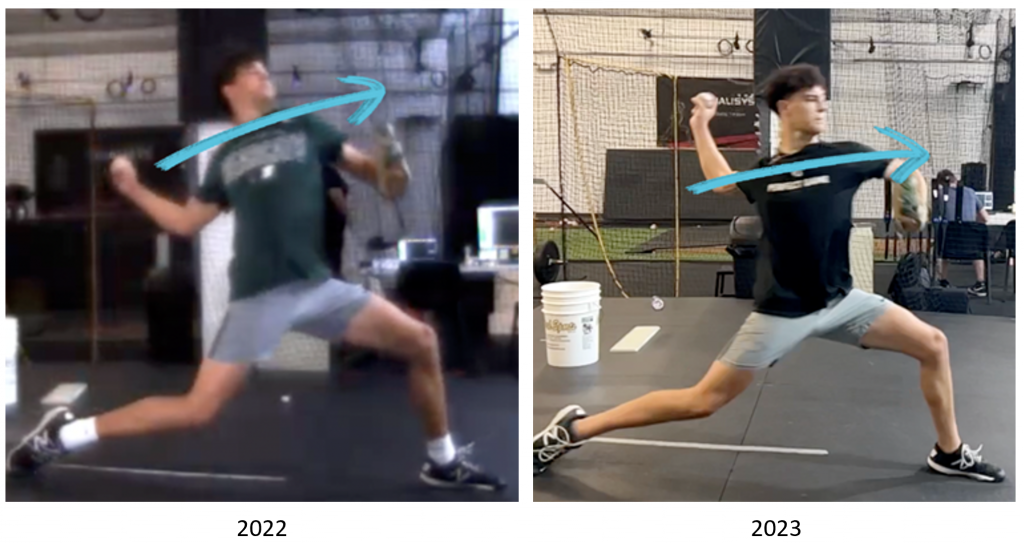
-
- Trunk Stack at FP – Trunk stack is the ability to keep the pelvis and upper body “stacked” from the beginning of the linear move all the way into FP. Failure to do so will make it difficult to achieve efficient rotation and forward trunk flexion to occur later in the delivery. Conner is now properly “stacked” during this delivery.
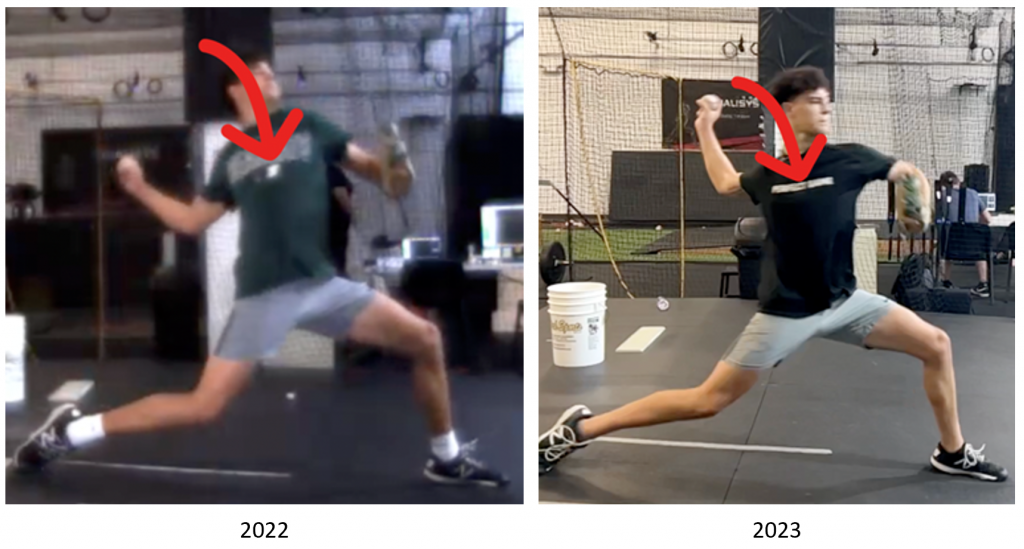
-
- Glove Side Position & Timing – Another added benefit of improving posture / COM is the ability to keep his glove side closed longer and allowing better hip / shoulder separation later closer to foot plant.
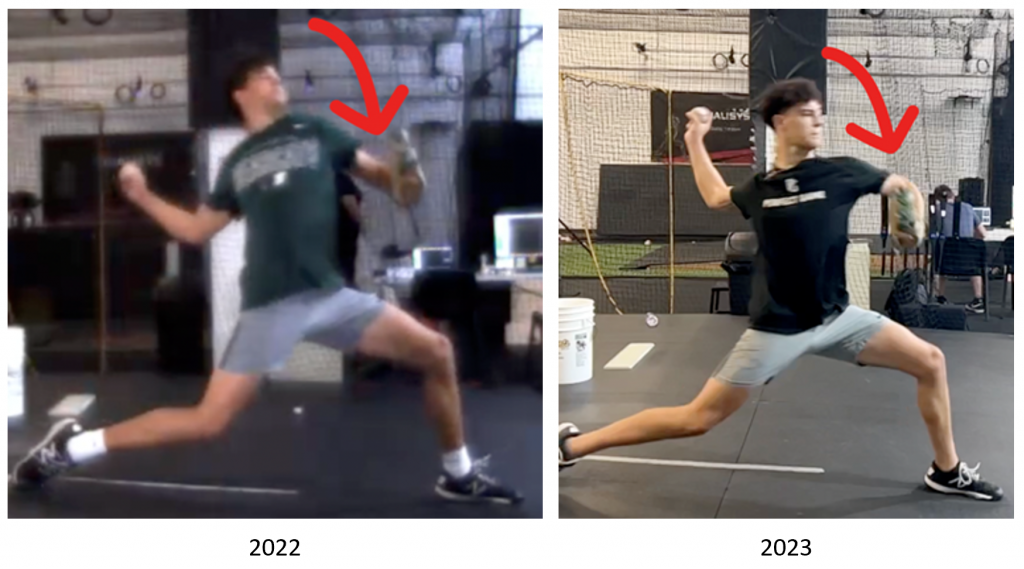
-
- Late Arm at FP – This was all about drill work and timing. Shortening up Conner’s arm path allowed him to get in a less “provocative” position with his arm/shoulder going into layback.
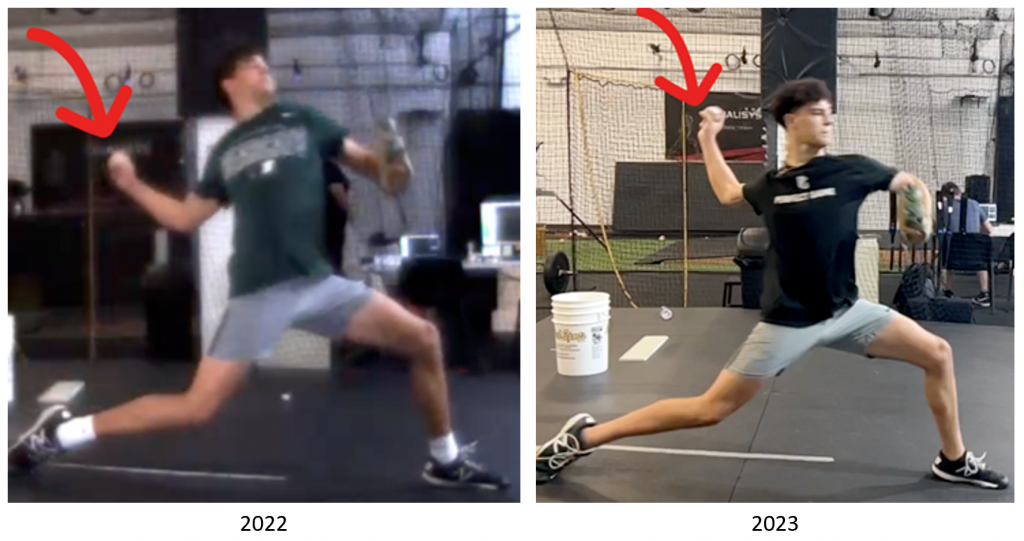
Summary
Overall, Conner’s reassessment processes was impressive to say the least. Being able to improve so many variables within a year has been a massive win for him. These improvements have helped him with a great start to his collegiate career at Binghamton University this fall, where he was recently clocked at 95 mph.
We’re looking forward to seeing what comes next from this guy!
By Jake Lebovitch and Nunzio Signore
You live too far to train with us in-house at RPP? You can now train with us on a REMOTE basis.


